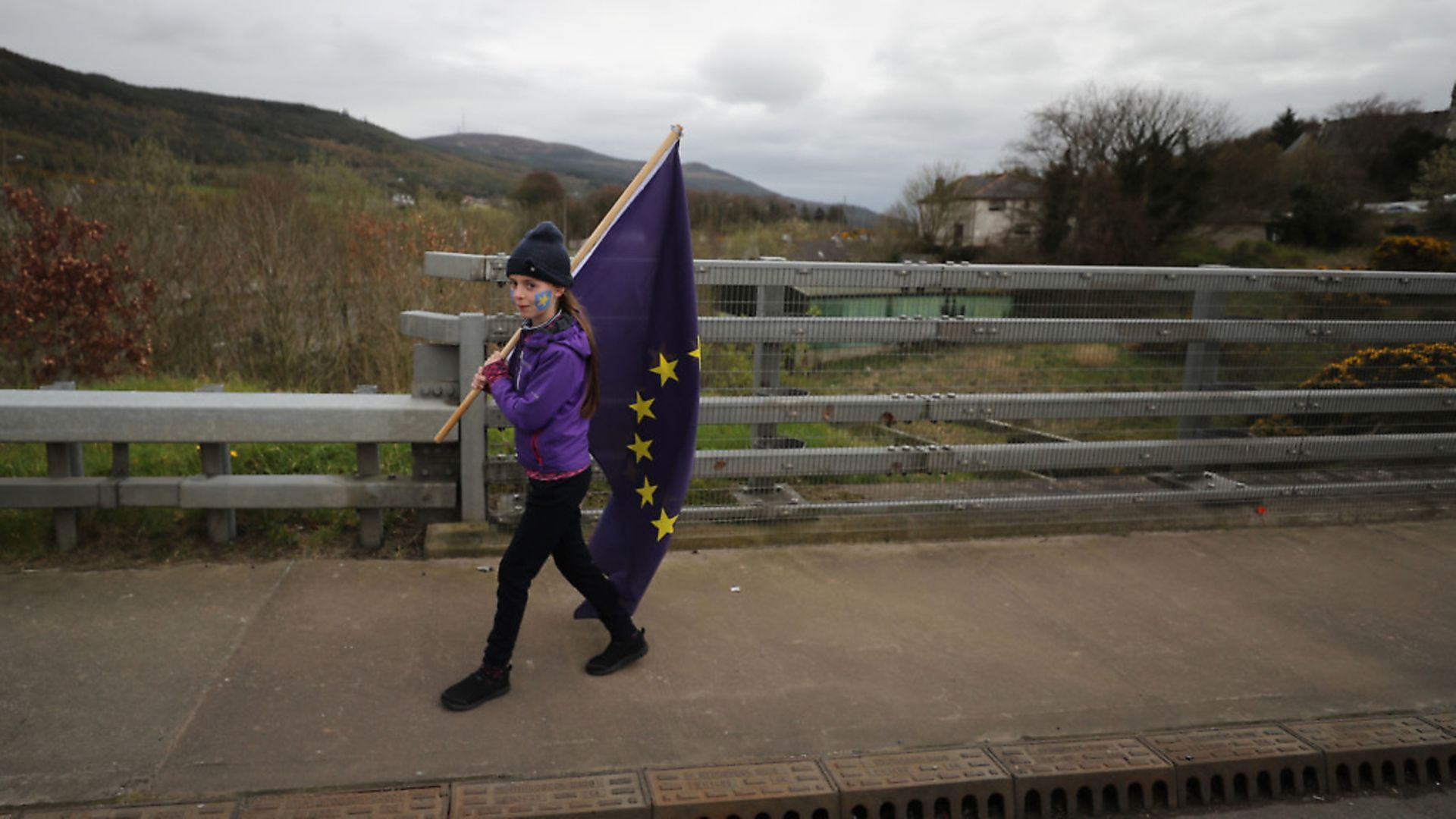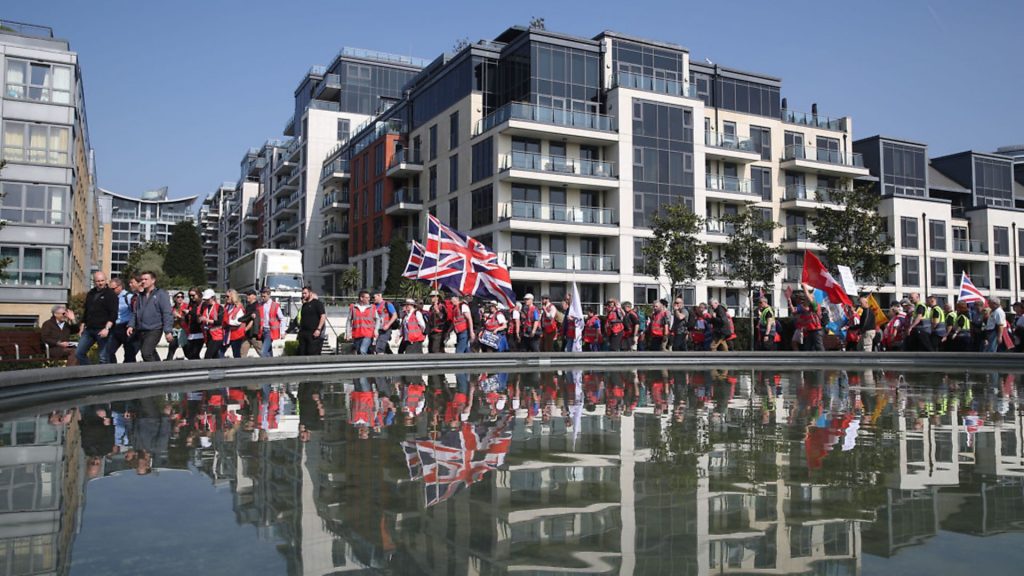
Fleet Street watcher LIZ GERARD on the contrasting ways in which the national press covered the pro- and anti-Brexit rallies.

A couple of weeks ago, hundreds of thousands marched through London to ask for a second referendum on Brexit. It was announced from the platform in Parliament Square that more than a million had taken part, a figure later disputed. There were certainly a lot.
Six days later, on March 28, thousands more were on the same spot for the culmination of the ‘Brexit betrayal’ march, protesting about the government’s failure to take the UK out of Europe that day, as promised.
Numbers for that demonstration were vague, with ‘tens of thousands’ a popular guess. But from the most generous (for the Leavers) and rigorous (for the Remainers) figures, it was clear that the first march had at least five times as many people as the second.
So how did press coverage of the two events compare? Let’s start with the treatment of the ‘Put it to the People’ march. As it was held on a Saturday, the Sunday newspapers had the first go. For the Remainer Observer, it was the splash with a big picture on the front, followed up with three inside pages and a leader urging MPs to listen and act.
The Leave-supporting Sunday Times and Sunday Telegraph both splashed on speculation of a cabinet coup against May, each including a single paragraph on the march in their lead stories. The Sunday Times preferred a file picture of May and David Lidington to a live photograph of up to a million people on the streets of London, while the Sunday Telegraph went for a woman soldier in Syria giving the V for victory sign to illustrate a completely different story, about the ‘defeat’ of Isis.
Inside, the Telegraph used a protest picture, but angled the story on doubts about the attendance figures, based on the thoughts of renowned crowd-counting experts, the Brexiteer MPs Peter Bone – ‘I very much doubt the turnout figure is correct’ – and Marcus Fysh – ‘I wouldn’t be surprised if they had overestimated their turnout figure’.
The Sunday Times meanwhile merged the march coverage with its inside political story.
The Mail on Sunday also splashed on the cabinet coup and put the march on the third spread under headline ‘March of the unbeleavers’, with a colour piece by Charlotte Gill.
Gill was not impressed at the move to ‘overturn the largest democratic vote in history’, a point reinforced with a rag-out of a tweet from Daily Mail columnist Sarah Vine saying: ‘Just remember, you are marching to overturn a democratic vote. You can tell yourselves that you are on the side of the angels, and maybe you are. But that’s the truth.’
Gill thought the marchers had lost the plot, but seemed surprised to conclude that they were also rather nice:
‘I worried, as a woman who – at 5ft 2in – is far from imposing, that I’d feel intimidated in these crowds. On the contrary, I was rather embraced. I even made the ultimate faux pas: I told people I’d voted for Brexit. It could easily have got ugly.
‘Expecting looks of horror – and perhaps a thrown quiche – I received only sympathetic glances and civility.’
Perhaps she might tell Vine (aka Mrs Gove), who had further tweeted that there wouldn’t be any Leavers on the march because they’d be lynched.
The Sunday Express was cute. Its splash headline started ‘Britain marches…’ but had no mention of the million (or even 400,000) or where they had marched; this Britain was marching ‘towards election disaster’. The London marchers were despatched inside, where they were paired with Nigel Farage’s guest appearance at his own trek from Sunderland.
Of the redtops, the Sunday Mirror and People both had big front page puffs and inside spreads. The People, whose main heading demanded ‘Are you listening Mrs May?’, also had an editorial article saying the people were crying out for resolution. The Star put the story on page two with a crowd photograph and completely straight heading: ‘Million march for a final say’.
Only one title – the Sun – publishes every day of the week, so let’s leave that until last and move on to how the daily papers approached the two marches.
In doing so, it’s worth making two points. First, by the following Monday the People’s Vote march was slightly stale – especially with Theresa May taking dictation from the ‘Grand Wizards’ at Chequers on the intervening Sunday – so it was unlikely to be page one news. Indeed, it didn’t make so much as a sentence on any front page.
Second, the Leavers’ turnout in Parliament Square the following Friday was bound to be smaller as it took place on a working day. But its very timing – on what was supposed to be Brexit Day – gave it a news edge. Colourful demonstrators (especially, as we shall see, pretty girls in short kilts) make for more appealing pictures than the usual suspect MPs.
The Remainer Guardian and the Times – which, unlike its Sunday sister, backed Remain, is doubtful about a second referendum and sees May’s deal as the least worst option – took a near identical approach. Both put the People’s Vote march at the heart of a second inside Brexit spread.
The Guardian using photographs of the speakers, the Times opting for the crowds, a pretty young woman with banner and a dog with a Theresa May doll to illustrate a story about the ‘Revoke Article 50’ petition hitting five million.
Come the following Saturday, both papers mentioned the Leavers’ march high in their lead stories, both gave further coverage on their second spreads, both ran march pictures featuring attractive women, both ran colour pieces that managed to be not too dismissive.
The i, which tries to be more even-handed on Brexit than its staunchly Remainer but now online-only Independent mothership, restricted its coverage of the People’s Vote march to a picture caption on its second spread.
After the Brexit rally, it covered all bases with a picture of an aggressive demonstrator in Downing Street on the front, the Leavers’ march story and pictures on its first inside spread, and a photograph of a Remain demonstrator on the second spread. That last was quite an achievement, since the otherwise ever-present Sodem protesters had abandoned Westminster for the day.
Last among the Remain (ish) tendency comes the Daily Mirror. The Monday paper’s only mention of the People’s Vote march was coupled with the ‘revoke’ petition in a single paragraph towards the end of the cabinet coup story. Pictures of Johnson, Rees-Mogg and Duncan Smith driving in or out of Chequers on Sunday were preferred to two-day-old protesters. Coverage of the Leave march on Saturday amounted to a montage of random pictures – with a pretty girl dominant – and a little caption story.
And so to the hardcore Brexit dailies.
For Monday’s Telegraph, the Remain march was worth a postage-stamp picture and couple of pars at the bottom of a small inside story about Philip Hammond saying a second referendum might be worth considering. The main image on the page was Jeremy Corbyn pretending to be Ernie Wise.
On Saturday, however, after the second march, a photograph of Leave protesters took up half the front page, there was a picture montage (including pretty girl in short kilt) to go with the political stories on the first spread, while a second spread was devoted to the demonstration. One story was headlined ‘Day Brexit voters found their voice’ (wasn’t that June 23, 2016?) and another asserted: ‘March 29 will now go down in history as a very British day of protest.’
It was the same story at the Daily Express. Monday’s paper ignored the People’s Vote march – it did report ‘outrage’ at Hammond’s hint on a referendum.
But Saturday’s edition came out with guns blazing for the Farage-fest, with a front-page picture behind the headline ‘We’ll never give up on the Brexit we voted for’ and an inside spread of pictures, albeit with very little text.
In the Mail, the ‘Put it to the People’ march was coupled with Brexity roadblocks for an essay by Dominic Sandbrook, who contrived to insult both Remainers and the BBC in his opening sentence before continuing ‘It’s easy to sneer…’
By Saturday the paper was incandescent after a week of seething at the goings-on in the Commons. The splash ‘The Brexit betrayal’ set the tone for 11 pages of coverage in which almost everyone from arch-villain Jeremy Corbyn to erstwhile heroine Priti Patel came under fire for failing to support the prime minister.
The Leavers’ march was almost light relief on the third inside spread with a giant crowd picture and a few inserts – including our friend in the mini kilt. A fairly even-handed colour piece from Robert Hardman described the event as amateur theatricals compared with the previous weekend’s ‘grand parade’ and cautioned politicians not to shrug off the event as the rumblings of a fanatical minority fringe.
Which brings us to the country’s best-selling paper. For Sunday’s Sun, the mass of humanity that had streamed through London was to be written off at the bottom of page two as the ‘Remoans of the day’, with snide speech bubbles superimposed on a crowd photograph and just four paragraphs of text. So little, that we may as well reproduce the story in full:
Placard-waving Remainers call on Theresa May to hold a second referendum as they march through London yesterday.
Messages of support from Stephen Fry, Gary Lineker and Delia Smith were shown.
Scotland’s First Minister Nicola Sturgeon said the PM should ‘let the people speak’ while Independent MP Anna Soubry urged politicians to ‘put your country first’.
People’s Vote campaign said a million people – plus dogs – had taken to the streets. But Tory MP Peter Bone dismissed the claim, saying: ‘It was hardly a march and more of a social gathering.’
Come Monday, the march was not only an unwelcome story, but also stale news. So there wasn’t a word in the paper. But on Tuesday, the Sun was happy to report that the attendance figure had been halved (courtesy of a website that mapped only the main route, not the side streets or the area before the official start) to a mere 400,000.
The Farage march, however, brought a collection of photographs (naturally, including pretty woman in kilt) on the second Brexit spread and twice as much writing, emphasising that the march (‘more than 10,000’) was ‘peaceful’ – in spite of a ‘darker mood’ later. The previous Saturday’s event had been even more peaceful, but the Sun didn’t notice.
So there we have it. Up to one million march, six million sign a petition, and half the press – the half with the mass circulations – downplay and deride.
The fact that it is entirely peaceful and friendly is barely noteworthy, other than as another excuse to mock the protest as an ‘elites outing’. There is no suggestion these people had anything to say that was worth listening to.
Yet when a fraction of that number turn out, they get full coverage. Scuffles and arrests, foul-mouthed confrontations with police, effigies being dragged through the streets and flags being burnt are all brushed aside as readers and politicians alike are urged to take heed.
Which of these events – if either – was the true voice of the people? Perhaps editors should take a look at the latest opinion polls.









